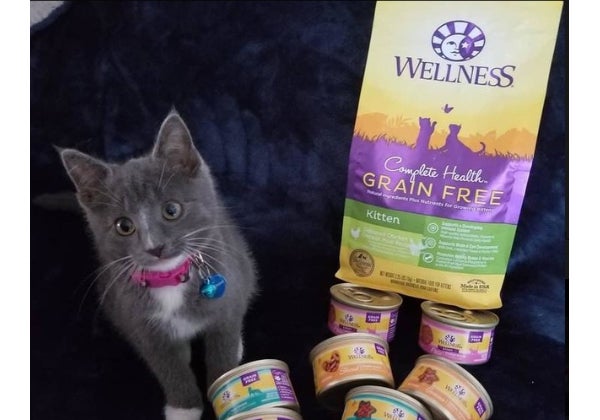January 9, 2020
Kitten Development Milestones to Watch For
Kittens grow up very fast especially during the first few weeks of their lives. Here’s a timeline of those captivating milestones so you can chart their development as they discover the wonderful world around them—and you.
Here’s what to expect:
Newborn Kittens
- Kittens are born blind and deaf.
- Eyes are closed and ears are folded at birth.
- No teeth yet.
- Around five days, eyes start opening and initially are blue in color.
- Around five days, ears start to unfold and they can begin to hear sounds.
During the newborn kitten stage, kittens are totally reliant on their mother. Keep in mind that if there is no mother cat, kittens require special 24/7 care including being fed a special kitten formula every two hours which is designed to strengthen their immune systems and build healthy bones. Never give a kitten dairy or other milk products that humans consume.
Two Week Old Kitten
- Wobbly movements. Kittens start to make wobbly attempts to stand up but remain very close to Mom and each other.
- First squeaky mewing sounds.
- The first of 26 baby teeth start to come in.
- No claw movement. They are still too young to be able to retract their tiny claws.
Three Week Old Kitten
- Eyes and ears are properly developed (although eyesight will still be a bit blurry).
- Kittens begin to move around more. It’s time to begin socializing with them, by introducing kitten toys.
- Introduce human touch. A mother cat will groom her kittens with her tongue. To get them used to being groomed by people, brush gently with a very soft toothbrush which replicates the feeling of a mother’s tongue.
Four Week Old Kitten
- Kittens are no longer considered neonatal.
- Appearance resembles fluffy baby versions of a full-grown cat.
- Kittens begin to explore their surroundings.
- Start to interact and socialize with them. Play time is a great way for kittens to build confidence around people. But don’t over crowd them. Toddlers and young children should be allowed to look but not touch. Kittens are very delicate.
- Ready to eat their first kitten dinner. Introduce them to very small amounts of soft food. Wellness® Complete Health™ Pâté Kitten Recipe that has been formulated to provide the extra energy kittens need in the form of calories, fat and protein to fuel their new exploratory adventures.
- Feed mom extra calories. In fact, Because the AAFCO nutrient profile is the same for growth and reproduction, you can feed the mother cat the same kitten recipe as she needs strength and energy to feed a litter of kittens! You can’t overfeed the mother cat given the amount of milk she is producing to feed a litter. Take advice from your veterinarian regarding her diet to ensure she remains healthy.
- Feed them alongside their Mom. This a great way to interact with them and still allow them to be close to Mom. Put the food on a flat bowl or large plate so everyone can gather around. Gently stroke the kittens so they know to stay put and eat.
- Kittens can be cleaned with a warm, damp paper towel.
- Introduce a low-profile litter box. Instinctively kittens know what to do in the litter box but will need help getting in and out!
Six Week Old Kitten
- Eyes are fully developed and focused.
- Kittens will start exploring short distances.
- Kittens start enjoying interacting with each other and their mother, practicing their pounce and play skills.
- Signs of your kitten’s individual personality starts to develop. Little kitten. Big personality!
- Baby teeth start to come in. Kittens teethe and will appreciate a special kitten teething toy. Keep it cool in the refrigerator when not in use.
Eight Week Old Kitten
- Kittens are weaned
- Earliest window for spaying and neutering (if the kitten weighs two pounds or more).
- Ready to be adopted into their forever homes.
- They will now only be eating a specially formulated kitten recipe or one suitable for all life stages. It’s a good idea to offer both wet and dry foods so that they get used to eating both.

- Feed small meals three times a day. Reference the feeding guidelines.However, if they seem hungry increase the amount. It’s difficult to overfeed a kitten at this age since they are growing so rapidly.
- Socialize your kitten. Get them used to being around people, but start slow. Not too many people at once.
- Introduce a grooming routine. By stroking them and playing very gently with their feet you are also priming them for a grooming routine (and mani-pedis) when they are older.
Ten Week Old Kitten
- All 26 baby teeth are in.
- They are now able to retract their claws.
- The eyes are now a permanent color.
- Personality with a capital P! Kittens develop distinctive and individual personality traits. They are all very curious, but some will be bold and others shy.
Sleeps less and plays more.
Twelve Week Old Kitten
- They need supervision. At this age, kittens are raring to go and will play fast and furiously, testing their abilities to climb and pounce, and then collapse to nap, recharge and start again.
- Confine them to one room when they are home alone. This is for their own safety. Remove heavy objects from shelves that could harm them if they fall during boisterous play.
- Reduce the amount of times fed daily to 2, while still referencing the food’s feeding guidelines.
Four Month Kitten
- This is an intense growing period for kittens. They expend boundless energy and will enjoy small toys to bat about.
- Their appetite continues to increase. Stick to the guidelines on the recipe and be careful not to overfeed.
- Begin leash training if desired. If you are planning to take her safely outdoors, consider purchasing a special kitten harness and 6-foot leash combo.
Five Month Kitten
- Their relative growth rate starts to slow as they approach six months.
- Young kittens can still reproduce! If you acquired a kitten from a friend and not from a shelter or rescue group, it is now imperative to ensure she has been spayed or neutered by the time she is five months old. According to research done by an organization called Marian’s Dream that runs a nationwide program called Feline Fix by Five, research has shown that if a cat is spayed before the age of five months, this can greatly reduce unplanned and unwanted kitten litters because young kittens can go into heat and thus, this greatly helps reduce the homeless cat population.
- Kitten vaccinations should now be complete.
Six Month Kitten
- Meet your fully-grown baby cat. Kittens are considered fully grown around six months of age. However, certain large breed cats can continue growing up to one year.
Nine Month Kitten
- Revisit dietary requirements. While kittens need a higher calorie food as they are growing, feeding such a formula after a young cat is fully grown can result in obesity.
- Check with the vet. Each kitten is an individual so it’s best is to ask your veterinarian about nutrition their specific nutrition requirements.
- The adult teeth are in. This is often when veterinarians suggest changing from a kitten food.
One-Year-Old Kitten/Cat
- At 12 months, physiologically, a kitten is now a fully-grown cat.
- Get ready for a teenage temperament. In terms of temperament and actions, a one-year-old cat is the feline version of a human teenager!
A Final Word on Kittenhood
If you are adopting and can afford it, two kittens are better than one. Cats love same-species companionship, especially if you adopt littermates. It means twice the fun and twice the love and they are less likely to be lonely when they are home alone.
If you recently adopted a kitten, please share photos of your fur baby’s magic milestones by tagging us with #wellnesspetfood and @wellnesspetfood for a chance to be featured on our website and social pages.






